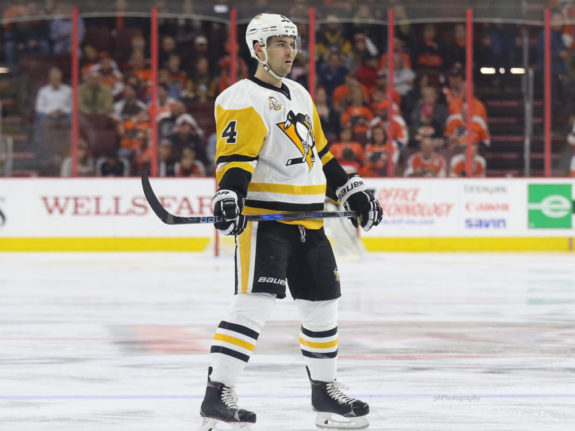As the Feb. 25 NHL Trade Deadline quickly approaches, general managers will need to consult their staff to see whether they want to be buyers or sellers. The Pittsburgh Penguins are hanging on for dear life to the final playoff spot in the Eastern Conference and if they want to be serious contenders to win their third Stanley Cup in the last four seasons, they need to be buyers.

The Penguins have already made a few moves to better position themselves offensively. On Nov. 14, they traded Carl Hagelin to the Los Angeles Kings in exchange for Tanner Pearson. After a hot start playing alongside Evgeni Malkin, Pearson has been a non-factor offensively and is currently practicing as the 13th forward due to the emergence of Teddy Blueger.
On Feb. 1, the Penguins traded Derick Brassard, Riley Sheahan and two draft picks to the Florida Panthers in exchange for Nick Bjugstad and Jared McCann. General manager Jim Rutherford basically admitted the Brassard experiment was a failure by trading him to the Panthers but he got a fantastic return in McCann and Bjugstad. Rutherford has never been trigger shy, and if the Penguins want to be serious contenders, they will need to continue to make moves.
The Penguins Need a Right-Handed Defenseman
Though Rutherford has made a few moves already, he has failed to address one of the most glaring needs on the Penguins’ roster: a right-handed defenseman. The only two notable right-handed d-men are Kris Letang and Justin Schultz. After missing the last 53 games, Schultz was finally activated off injured reserve and returned on Feb. 16 against the Calgary Flames, but the Penguins still need to add a third right-handed defenseman to round out their defensive core.

Chad Ruhwedel is right-handed, but he is considered the eighth defenseman on the depth chart. There are many difficulties that come with two left-handed defensemen playing together. First off, it places them in awkward situations as they retrieve the puck in their own end. When two left-handed defensemen is playing together, it’s easy for the opposing forwards to force one of them to their backhand on the breakout, which can cause turnovers and lead to scoring chances.
While the disadvantages are less risky in the offensive zone, they are still there. With two left-handed defensemen in the offensive zone, it limits the opportunity for one-timers to the right side of the ice. Opposing teams can focus on playing deep in their own zone, forcing the puck up high, and then making the Penguins move the puck to the weak side. The split-second difference in a one-timer and a defenseman having to corral the puck before shooting is the difference between a shot getting through and a shot getting blocked.
With plenty of left-handed defensemen to spare, look for the Penguins to entertain moving either Olli Maatta or Jack Johnson to a team in the Western Conference in exchange for a right-handed defenseman.
Penguins Have Plenty of Trade Bait
The two most difficult aspects of making a trade are finding a suitable trade partner and having tradable assets. There are plenty of teams who will be selling at the deadline, so finding a partner shouldn’t be too difficult, and the Penguins have a plethora of trade bait. They have 14 forwards who all have a legitimate argument to be in the lineup every night, the problem being that head coach Mike Sullivan can only dress 12.

With a completely healthy lineup, Dominik Simon and Tanner Pearson are the two odd men out. Simon, who has 21 points in 48 games the season, would be attractive to any team trying to add offensive depth to their roster. At just 24 years old, there is still room for him to improve and be a consistent top-six forward in an NHL lineup, but the Penguins are just too deep up front to accommodate him.
After being traded from the Kings, Pearson made an immediate mark on the Penguins by scoring three goals in his first six games and earning a plus-three rating, but as the season progressed, Pearson’s impact became minimal. In his last 31 games, he only has six goals, four assists, and a minus-eight rating. At 6-foot-1, he is a big-bodied forward with an incredible shot, but his pass-first tendencies have led to his offensive struggles. In his last eight games, he has only five shots on goal.
Even with his offensive struggles, Pearson has shown scoring potential earlier in his career and can flourish in the right system. If a potential trade partner wants to add some size to their roster and perhaps another shot to their second power-play unit, Pearson could be a good fit.
There are plenty of other expendable players on the Penguins’ roster that could gauge interest from teams, but Rutherford needs to be careful that he doesn’t get rid of an important piece. Fact is, the Penguins cannot match up with the Toronto Maple Leafs or the Tampa Bay Lightning, who are the two favorites to come out of the Eastern Conference. If they want to change that, the Penguins must be buyers and find a way to improve the lineup immediately.